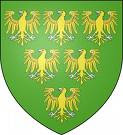Any fiction book, and even some non-fiction books,
portrays the relationship between Piers Gaveston and Isabella, wife and Queen
of Edward II, as one of either dislike or hatred. There are tales of Isabella watching in
horror as her husband disembarks on his arrival back in England, crashing
through the surf, to embrace and kiss Piers, not caring what anyone
thinks. Isabella is then humiliated during
the Coronation, where Piers holds centre stage, and then the banquet when even
more humiliation is heaped on her as the arms of Edward II and Piers Gaveston
adorn the hall and Edward ignores his wife, the food is burnt, Isabella’s
uncles, the counts of Valois and Evreux storm out in disgust, Isabella writes
to her father bemoaning the neglect her husband has for her, and that he has
even given all her wedding presents to Piers, who flaunts her jewels in front
of everyone. No wonder Isabella hated
Piers, right? Except all is not quite
what it seems.
Isabella never saw her husband embrace Piers as soon as
he set foot back in England, her uncles, although they did complain on their
return to France, did not storm out of the banquet, there are no letters
written by Isabella to her father from this time and of course, the wedding
gifts were Edward’s, and he could do with them what he wished – even give them
to Piers for safe keeping. The negative
stories emerge from chroniclers from the time or later, and we actually don’t
know how Isabella or Piers felt about each other. So in this post, I will offer my
interpretation, which are just as valid as Thomas Walsingham’s or Agnes
Strickland’s.
Isabella was only 12 when she married Edward – both Edward
and Piers were in their 20s and already had a life-long bond – whether as a
brotherhood or lovers. Both men had
illegitimate children, both married and had legitimate children with their
wives. So even if they were lovers,
they both had had relationships with women and knew society’s expectations of
them – to marry and produce heirs. What
better way for Edward to show his affection to Piers and bring him into the
royal family by marring him to his niece, Margaret de Clare. Edward himself showed no reluctance to marry
Isabella. But as she was only 12, what
interest could she have held for him?
She was still a child, and far too young to share the royal bed. Surely Isabella herself did not expect to
share her husband’s bed at such a tender age?
And her father, King Philip, would surely never allow it. At 12, her body was too young to bear a
child, and she may not even have started her periods. There must surely have been some agreement to
wait. Philip must also have been aware
of Piers Gaveston. He would have known
about the exile of the favourite by Edward 1st, and the indecent
haste in which Edward II recalled him after his father’s death. While
he may not have cared about any sexual relationship between Edward and Piers,
hoping it would be discreet, he would have wanted to know how the relationship
affected the court. Would he send his
daughter totally unprepared to England without any inkling of who Piers
Gaveston was? I doubt it. Sending her uncles to support her, Isabella
may even have been advised to try to please Gaveston, or to try to get along
with him. There is no way she could have
insisted as a 12 year old that her husband banish his friend.
Of course, Edward’s actions at the Coronation and the
banquet were insensitive to his wife and no doubt offensive to the English
nobility. It’s my opinion that Edward
saw his Coronation as almost his and Piers – he certainly didn’t want to share
the limelight with a 12 year old girl, and he wanted to send a message to his
nobles – Piers might have been exiled by his father, but now he was exalted
above all. Married into the royal
family, allowed to wear purple (a royal colour), and taking a lead role in the
Coronation, Edward couldn’t have made his thoughts clearer. Displaying the Royal arms and Gaveston’s at
the banquet, and making such a public display of his affection for Piers in
front of everyone, Edward was setting the tone for his reign. No doubt he was thoughtless and tactless
towards his wife – but this was more about sending a message to his nobles. Isabella had had her introduction to life at
the English court and Piers Gaveston – no doubt she felt humiliated, but she
knew she would find a way to live with Edward – and Piers.
I hope to write a follow-up to this post soon - how the relationship developed, and what did Piers think of Isabella.








